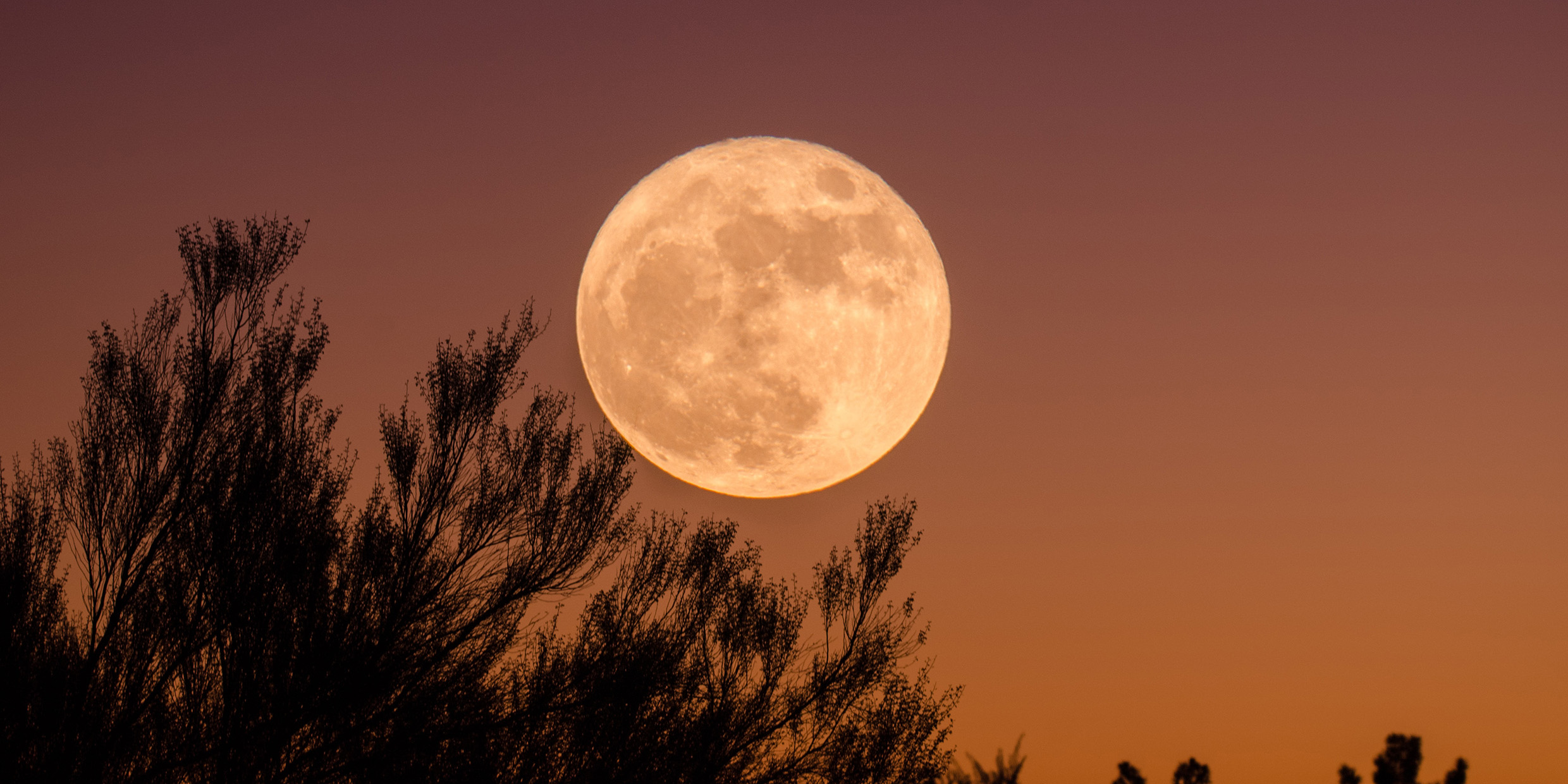Originally published 19 June 1989
At 1:58 this morning the moon was full. Last night and again tonight it will rise in the east at sunset, huge, golden, glorious.
The full moon of June is called the Rose Moon, Flower Moon, or Strawberry Moon. It might also be called the Honey Moon, since June is the traditional month of marriage. The honeymoon was originally the first month after the wedding, when (according to Samuel Johnson) “there is nothing but tenderness and pleasure.” Less romantic Renaissance writers pointed out that the honeymoon, like the moon itself, is no sooner full than it begins to wane. June brides and grooms take note!
Guy Ottewell, who publishes an annual calendar of events in the sky, believes that the word for the post-nuptial month (and today’s wedding trip) might have been suggested by the color of the midsummer full moon: honey-colored because it is seen lower in the sky. In June the sun is high in our sky and the full moon, which is always directly opposite the sun, takes a low trajectory across the dome of night. This year, because of the tilt of the moon’s orbit, the full moon of June is about as low in the night sky as it ever gets. Even at midnight it stands only 20 degrees above the southern horizon, tinged golden by the atmosphere. Newlyweds celebrate its honey light.
The time is mostly past when the light of the full moon usefully extended the activities of the day, but sky lore reflects the old ways. The full moon of July is called the Hay Moon, and its light gave farmers extra time to bring in the hay before rain. The full moon of May is the Planting Moon, and the full moon nearest the autumn equinox is the Harvest Moon. The next full moon after the Harvest Moon is the Hunter’s Moon; the fields have been reaped and hunters can more easily see nocturnal animals that come out to feed.
Moonlight meetings
Two hundred years ago, before electricity, a full moon made it possible to travel safely at night. In England, a group of entrepreneurs, including Josiah Wedgwood (of china fame), Matthew Boulton (of steam engine fame), and Erasmus Darwin (of grandson fame), were just being practical when they established a Lunar Society that met each month on the night of the full moon to socialize and exchange ideas. In the course of their moonlit meetings they consolidated the Industrial Revolution and helped launched humankind upon a new course of middle-class democracy.
But who looks any more at those little symbols of the moon’s phases that still decorate our calendars? Our year stays in synch with the Earth’s orbit around the sun, and our clocks follow the spin of the Earth on its axis, but the moon symbols wander all over the pages of the calendar. A full moon can occur on any day of the month and the day varies from year to year. The month and the moon have been disconnected.
In fact, we have lost almost all cultural connections with the moon. No one makes hay by moonlight any more because no one makes hay. Menstruation may occur monthly in response to some ancient entrainment by the moon, but no woman watches the moon to predict her flow. Only sailors who live by the flow of tides still mind the moon in her phases.
Sailors and night-time walkers. Each month when the moon is full I take to the woods and meadows. It’s the time of the big-eyed creatures — the woodchucks, opossums, raccoons, foxes, skunks, and owls. It’s the time of the music-makers — the bullfrog, cricket, and amorous woodcock. It’s bat time. Glow-worm time. Snail and slug time.
The world is different by moonlight. Moonlight dissolves distances, compresses miles of scenery into flats, like stage sets. Each turn in the path is like a card turned over in a game of showdown; you don’t know what you will find there — a specter, a vampire, a rush of wings, a pair of eyes. You see with your ears. Nature at night is flutter, scuttle, and slink.
Thoreau was a night-time walker. The outdoors at midnight, he said, is as unknown to most of us as central Africa. He wanted to explore it and didn’t waste full moons: “What if one moon has come and gone with its world of poetry, its weird teachings, its oracular suggestions, and I have not used her? One moon gone by unnoticed?”
The lunar pull
Walking by moonlight Thoreau felt a tide in his thoughts. A moon tide. Pulling him upward. “How insupportable would be our days,” he wrote in an essay on night and moonlight, “if the night with its dews and darkness did not come to restore the drooping world.”
None of the other inner planets has a moon as big and bright as ours. The tiny Martian moons, Phobos and Deimos, provide far too little light for midnight walks on that planet. Phobos sheds about as much light on the surface of Mars as Venus does on Earth. The light of Deimos is comparable to the light of a star.
Earth’s moon is improbably big. Mysteriously big. Possibly it’s a huge dollop of rock splattered into space when the Earth was struck by a Mars-sized body early in its history. Whatever its origin, Earth’s full moon sheds a thousand times more light on the planet than all of the stars together. It is 400,000 times less bright than the sun but adequate illumination for night-time walking.
And that’s why I want to know when the moon is full. It’s the midsummer, moon-walking time of month. Like Bottom in Shakespeare’s A Midsummer Night’s Dream, I keep my eye on the calendar: “A calendar, a calendar! look in the almanac; find out moonshine, find out moonshine.”



